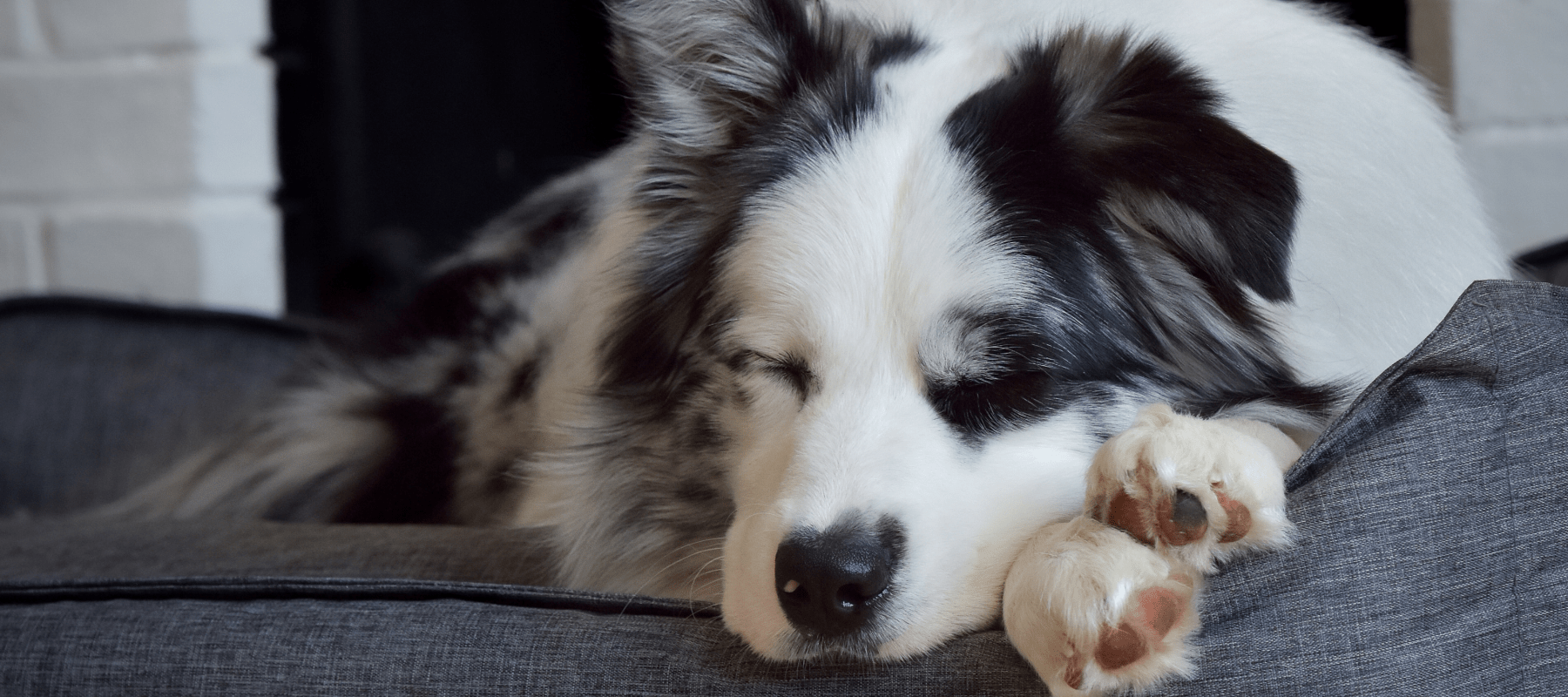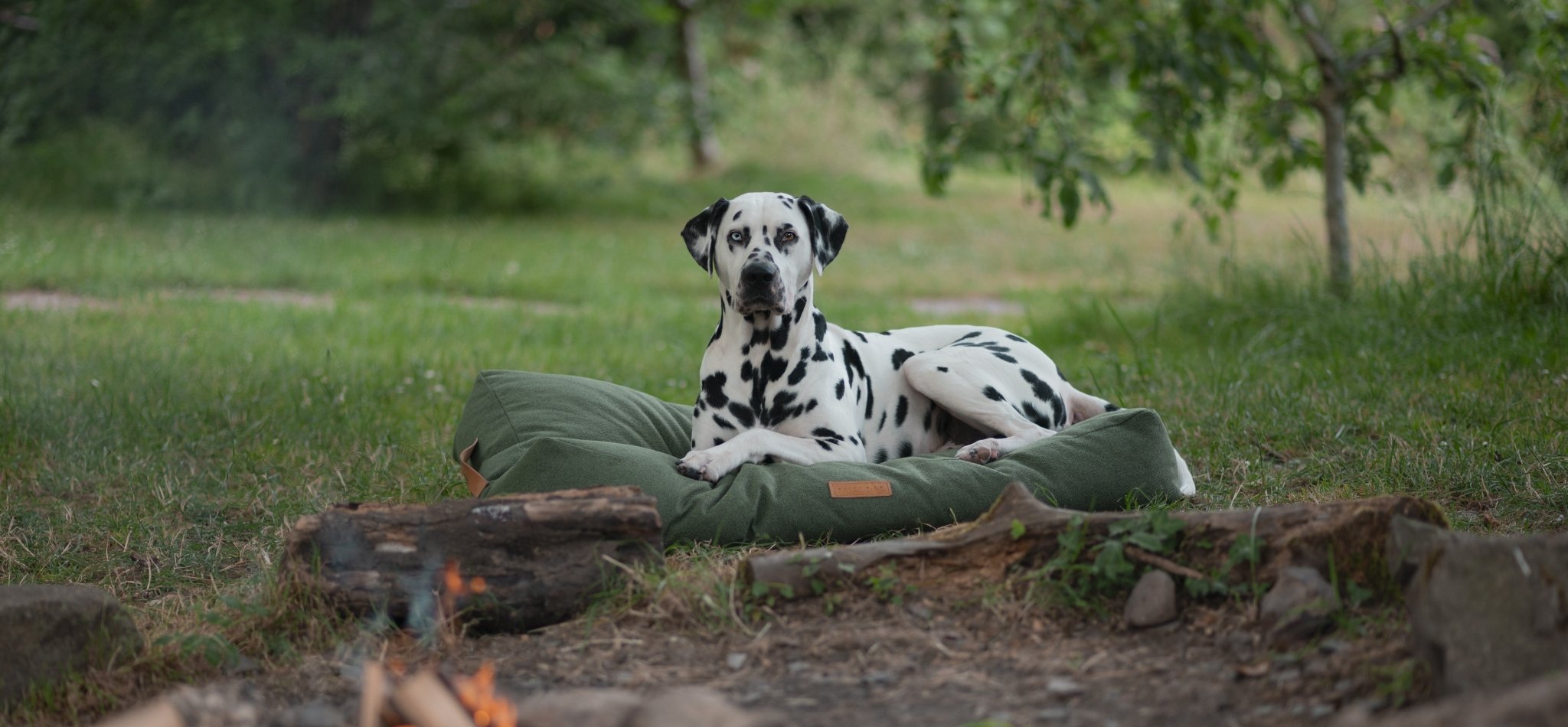
Why does my puppy destroy their bed? Answering your Frequently Asked Questions about Puppyhood...
Bringing home a new puppy is a wonderful, exciting, stressful whirlwind. With all the chewing, peeing and jumping you might not know which way is up. But don’t worry, we have you covered.
We spoke to Clara from Clara’s Canine Academy, a VSA Certified Positive Reinforcement Dog Trainer to answer all the questions you have about your new puppy. Read on for training advice and more…

Question: Why is my puppy destroying their bed and how can I stop this?
Answer: It's frustrating to wake up and find your puppy has shredded their brand new luxury dog bed. To stop this behaviour, you need to understand what's driving it. All behaviours serve a purpose for your dog, which is why they continue doing them.
There are a few reasons why your puppy might have adopted this habit, so let's explore them.
1. Teething
One common reason for destroyed beds is teething. Around 3 months old, puppies start losing their "piranha teeth" and get their adult teeth, though some start as early as 8 weeks. To check if your puppy is teething, gently pull back their lips to expose the gums. Teething puppies will have red, swollen gums where the gum meets the tooth.
To soothe a teething puppy, give them a frozen carrot. A cold carrot helps soothe their gums and provides a healthy, low-calorie snack rich in Vitamin A. If your puppy doesn't like carrots, try freezing their food inside a Kong toy for a similar soothing effect.
2. Anxiety
Your puppy is navigating a new, scary world and adjusting to life away from their siblings, which can cause anxiety. Chewing and shredding are instinctive ways they cope, but this behaviour needs addressing.
To help your puppy create a positive association with their crate, make a cosy, den-like space with their blankets and toys. Feeding them in the crate reinforces this positive connection. Keep the door open during the day so they can explore their new den freely.
Gradually train your puppy to be comfortable alone by starting with short periods of alone time and slowly increasing the duration. Over time, your puppy will feel secure and learn to enjoy their crate.
3. Boredom
Like humans, boredom is common in growing puppies, but it's especially likely in high-energy breeds. Ensure your puppy has a set schedule with ample exercise, enrichment and nap time. If you can't spend one-on-one time with your puppy, provide a snuffle mat, puzzle toy or chew to keep them occupied.
A consistent schedule helps maintain their daily routine, and gets them used to a regular bedtime, which encourages relaxation.
Managing Unwanted Behaviours
It might take a few days to determine why your dog is destroying their bed. It's crucial to stop the chewing early to prevent it from becoming a habit.
Clara explains how to manage this behaviour: "During the day, if you suspect your new puppy will chew or become destructive when unsupervised, remove their bed and replace it with an appropriate chew or toy. At bedtime, give them a lick mat, as licking releases calming endorphins and helps your dog relax."
If the chewing persists or becomes excessive, it might be time to hire a professional trainer to break the cycle.

Question: How can I make sure my puppy’s collar is the correct size and how do I measure it?
Answer: Ensuring your puppy's collar fits correctly is vital for their safety and comfort when out of the house.
Here's how to measure and fit your puppy's collar correctly:
-
Measure the Neck:
- Use a soft measuring tape and place it snugly around your puppy’s neck.
- Insert two fingers between the tape and your puppy’s neck to ensure comfort.
- Note this measurement - this is your collar size. As for growing room, this will depend on the breed of your puppy, but as a general rule - choose a collar that falls within this measurement range. For example, if their neck measures 35 cm, select a collar that adjusts from 34-40 cm.
-
Fit Tests:
- D-Ring Test: Hold the collar’s D-Ring and move the collar around your puppy’s neck. It should move easily while still touching the neck. If it moves with resistance, it's too tight; if it moves too easily, it's too loose.
- Ear Test: Gently pull the collar up towards your puppy’s ears. It should not slip over the ears easily but should also not be so tight that it pulls at the neck. The collar should have some movement without causing discomfort.
Question: How do I stop my puppy peeing in his bed?
Answer: Creating a consistent schedule is crucial for house training your puppy and preventing accidents in their bed. Here are steps to help:
-
Establish a Schedule:
- Puppies have small bladders and need frequent bathroom breaks. A good rule of thumb is that a puppy can hold their bladder for about 30 minutes per month of age (e.g., a 4-month-old puppy can hold it for about 2 hours).
- Set a timer on your phone to remind you of regular toilet breaks, adjusting based on your puppy’s needs.
-
Toilet Training Routine:
- Take your puppy outside immediately after eating, drinking, playing, and before bedtime.
- Praise and reward your puppy when they do their business outside to reinforce good behaviour.
-
Clean Up Accidents Properly:
- If your puppy has an accident, especially in their bed, clean and disinfect the area thoroughly. Dog urine contains ammonia, which can attract your puppy back to the same spot.
- Use a disinfectant that breaks down ammonia and enzymes to remove the scent completely.
-
Monitor and Adjust:
- Pay attention to your puppy's signals and adjust the schedule if needed. Some puppies might need more frequent breaks depending on their breed and size.
Following these steps will help train your puppy to do their business outside and prevent bed-wetting incidents.
Dog beds recommended by dog trainers
Keeping this in mind, Clara's top recommendation for people struggling with puppy accidents is to invest in a waterproof, washable dog bed.
The waterproof lining helps to prevent accidents, spills and drools from seeping into the mattress, meaning no more worrying about stains or odours ruining the bed!
Our collection is also wipeable, making for an easy and efficient cleaning process. The covers are machine washable, making it our easiest dog bed yet for maintenance, ensuring your puppy has a fresh, comfy bed every night.

Question: How do I socialise my puppy and teach them to settle in public?
Answer: Socialising your puppy and teaching them to relax in unfamiliar environments is crucial for their development.
Here's how Clara recommends approaching socialisation:
-
Start Early:
- Socialisation begins as soon as your puppy is born and continues up to around 16 weeks of age. This period is when they are most open to new experiences.
- Socialisation begins as soon as your puppy is born and continues up to around 16 weeks of age. This period is when they are most open to new experiences.
-
Gradual Exposure:
- Introduce your puppy to different stimuli gradually, using positive reinforcement and patience. Expose them to various environments, people, and animals in a controlled manner.
- Introduce your puppy to different stimuli gradually, using positive reinforcement and patience. Expose them to various environments, people, and animals in a controlled manner.
-
Teach 'Settle' Command:
- Train your puppy to settle on command in a structured training session. Begin in a quiet, minimally distracting environment at home.
- Use a blanket or mat as a cue for your puppy to lie down. Click and reward when they follow the cue, gradually increasing the duration of the 'settle' behaviour.
-
Practice in New Environments:
- Once your puppy is comfortable settling at home, practice in new environments. Bring their blanket or mat to help them associate the behaviour with different locations.
- Start in quieter, less stimulating places and gradually increase the level of novelty and activity.
-
Provide Distractions:
- Give your puppy long-lasting chews or lick mats to keep them entertained while you focus on training in unfamiliar environments.
- Give your puppy long-lasting chews or lick mats to keep them entertained while you focus on training in unfamiliar environments.
-
Be Patient and Persistent:
- If your puppy struggles, go back a step and decrease the level of distractions. Continue practicing and gradually increase the challenge as they become more comfortable.
Consistent training and positive reinforcement will help your puppy learn to settle in public and become well-socialised. For more tips on socialisation, check out Clara's socialisation checklist.
Question: How do I get my puppy to relax in his crate at bedtime?
Answer: Creating a consistent schedule for your puppy is key to helping them relax in their crate at bedtime.
Clara explains how to effectively establish your puppy's bedtime routine:
-
Download a Puppy Schedule:
- Download a puppy schedule. This will provide your puppy with consistency and routine in an unfamiliar environment, aiding in preventing accidents and behaviour issues.
- Download a puppy schedule. This will provide your puppy with consistency and routine in an unfamiliar environment, aiding in preventing accidents and behaviour issues.
-
Afternoon Activities:
- Plan your afternoon activities in a specific order to prepare your puppy for bedtime.
- Include playtime, potty breaks, dinner, an evening walk, and then bedtime in the schedule.
-
Consider the Order:
- The order of activities matters. For instance, avoid playing with your puppy right before bedtime as it may make them too excited to settle down.
- Ensure your puppy has a potty break after dinner to prevent accidents in the crate during the night.
By following a structured schedule and considering the order of activities, you can help your puppy relax and settle comfortably in their crate at bedtime. For added comfort, spoil them with a puppy bed, a collection of smaller nest beds with the same award-winning design that naturally calms them while they nap.

Training Exercise
If your puppy doesn't enjoy spending time in their crate or being alone, it's important to gradually acclimate them to this. Below we share a few key tips from Clara to help make training a breeze.
-
Create a Den-Like Environment:
- Line the crate with a fluffy, cosy bed like the one from Ralph & Co, ensuring your puppy has a comfortable place to rest.
- Cover the crate with a blanket to provide a sense of security and reduce exposure.
- Offer a toy or chew to keep your puppy entertained and engaged while in the crate.
- Place one of your t-shirts in the crate to provide your scent, helping your puppy feel more comfortable.
-
Leave the Crate Door Open:
- During the day, keep the crate door open so your puppy can enter and exit freely. This prevents them from feeling trapped and allows them to explore the crate at their own pace.
- During the day, keep the crate door open so your puppy can enter and exit freely. This prevents them from feeling trapped and allows them to explore the crate at their own pace.
-
Create Positive Associations:
- Feed your puppy their meals in the crate to associate it with positive experiences.
- Provide chews, enrichment games, and other enjoyable activities in the crate to reinforce the idea that good things happen there.
By implementing these steps, you can help your puppy develop a positive association with their crate and feel more comfortable spending time there. Remember to be patient and consistent in your training efforts.
We hope you have a wonderful experience brining your new puppy home and teaching them the ropes.



Leave a comment
This site is protected by hCaptcha and the hCaptcha Privacy Policy and Terms of Service apply.